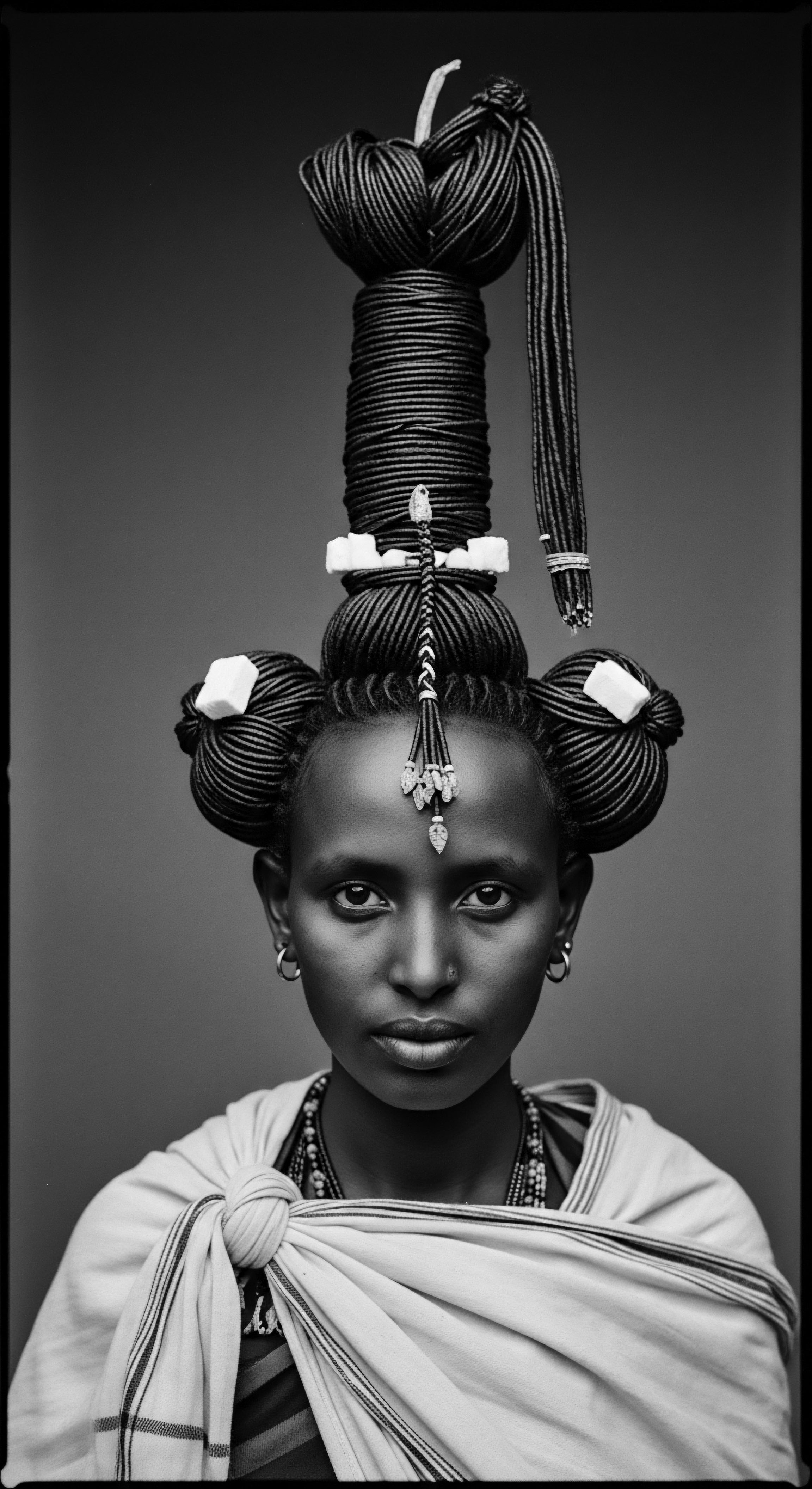
Roots
Consider for a moment the very strands that spring from the scalp, carrying within them not merely the blueprint of biology, but the whispers of generations past. Each coil, each curve, each cascade holds a lineage, a testament to the journeys undertaken by our forebears. For those whose ancestry traces through the richly textured spectrum of Black and mixed-race heritage, hair is never just hair; it is a profound connection to a deep, unbroken line of wisdom, care, and identity.
This journey into ancient Egyptian hair care, therefore, becomes a pilgrimage into the very heart of that heritage, revealing how practices honed in the crucible of time continue to echo in our modern understanding of hair’s innate vibrancy. We seek to understand the very foundations upon which these ancient traditions were built, observing how the Egyptians recognized and honored the unique qualities of diverse hair types, even as they lacked our contemporary scientific language.
The sands of Egypt cradle stories of meticulous grooming and stylistic expression, a society that placed considerable value on personal presentation in both life and preparation for the hereafter. This concern extended deeply to hair, a medium for societal signaling and spiritual connection. The foundational insights from ancient Egyptian practices offer a compelling lens through which we can observe the earliest documented approaches to hair management, many of which bear striking similarities to current textured hair routines. They understood the need for protection, moisture, and ornamentation, concepts that remain central to healthy hair upkeep across the diasporic world.

Hair Anatomy and Physiology from Antiquity to Today
While ancient Egyptians lacked the sophisticated microscopic tools available to modern trichology, their practical engagement with hair revealed an intuitive understanding of its fundamental nature. They recognized hair as a living extension of the body, susceptible to environmental conditions and requiring constant attention. The robust preservation of hair on mummified remains, often still adorned in intricate styles, attests to their effective methods for maintaining hair integrity, even beyond life’s fleeting span. The structure of hair—its keratinized protein filaments—would have been perceived through its tangible qualities ❉ its capacity to retain style, its susceptibility to dryness in the desert climate, and its response to various botanical and animal-derived applications.
For textured hair , this ancient wisdom holds particular weight. The coiled nature of many Black and mixed-race hair types presents unique challenges and gifts ❉ a greater propensity for dryness due to the open cuticles and winding shaft, yet a remarkable ability to hold intricate styles and protective configurations. The Egyptians, through trial and observation, developed a care philosophy that instinctively addressed these needs. Their use of oils and fats, for example, speaks to an early recognition of hair’s lipid requirements, crucial for maintaining suppleness and strength, particularly for hair prone to moisture loss.
Ancient Egyptian hair practices offer a historical mirror for understanding contemporary textured hair care.

Understanding Hair’s Cycles in Ancient Egypt
The life cycle of a hair strand, from its initial sprouting to its eventual shedding, was likely observed through the constant renewal of hair. While they would not have articulated it in terms of anagen, catagen, and telogen phases, the Egyptians certainly understood that hair grows, sheds, and can be encouraged to stay healthy. This understanding is reflected in their hair loss remedies, which often incorporated ingredients believed to stimulate growth or strengthen the hair shaft.
Environmental factors, such as the arid desert air and intense sun, undoubtedly shaped their care practices. The hair’s natural defenses against such elements—its sebum production, for instance—were likely supported by external applications, creating a barrier against desiccation and sun damage. This mirrors how contemporary textured hair routines often prioritize sealing in moisture and offering environmental protection.
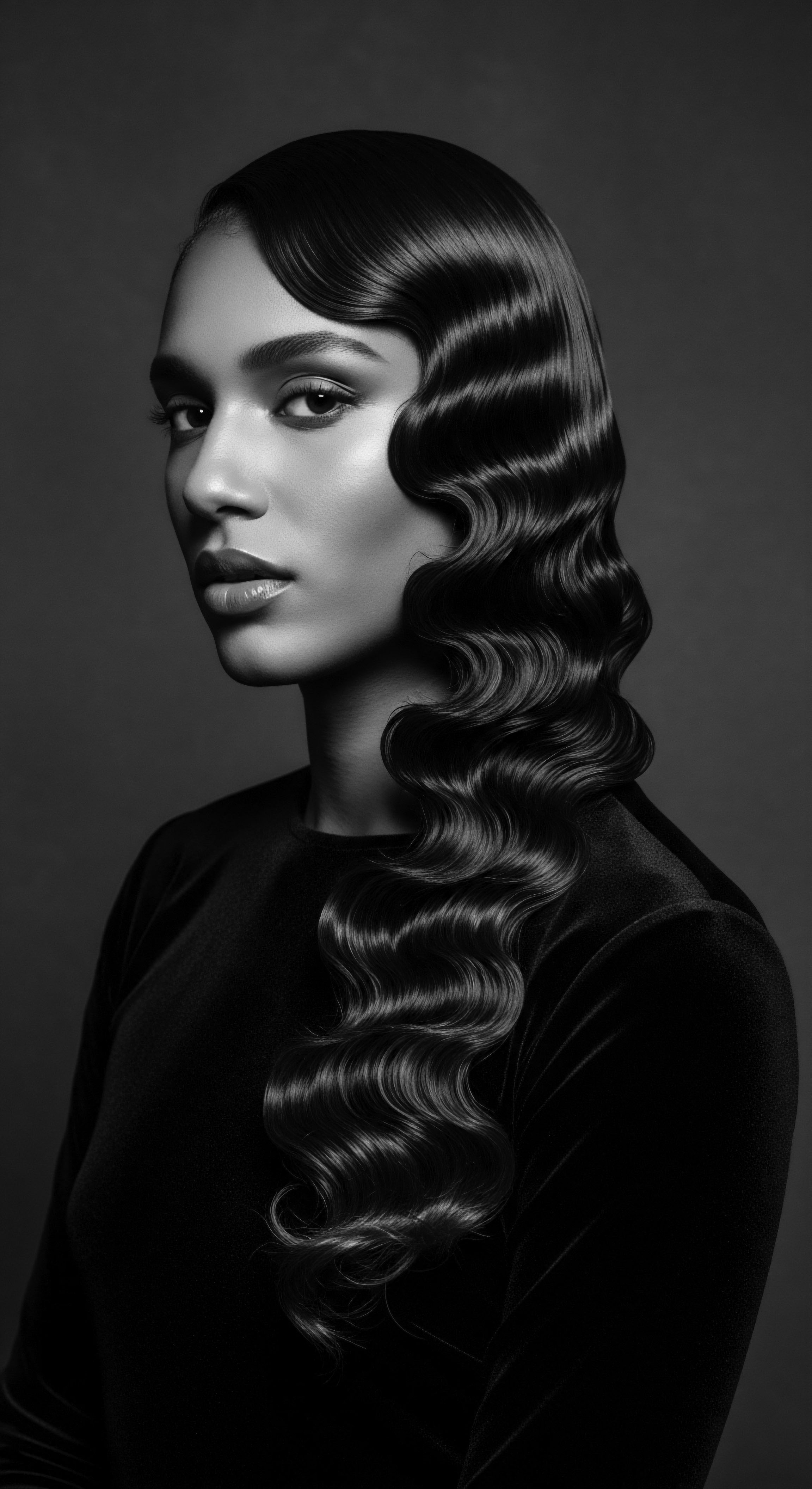
Traditional Hair Categorization and Cultural Relevance
Ancient Egypt’s approach to hair categorization was deeply interwoven with social structure, status, and gender roles rather than a modern scientific classification of curl patterns. Hairstyles, and by extension, hair care, served as visual markers within society. The elite, for instance, often wore elaborate wigs, signaling wealth and status, while others maintained their natural hair, which was often a reddish-brown hue.
(Salama and Kandil, 2018). This visual distinction speaks to a cultural understanding of how hair conveyed meaning.
The concept of hair as a symbol of identity runs as a powerful current through ancient Egyptian society. From the distinct side-lock worn by children, symbolizing youth and protection, to the elaborate coiffures of queens and pharaohs, hair communicated one’s place in the world. This social coding of hair finds a profound echo in the heritage of Black and mixed-race communities, where hair has historically been a potent visual language for identity, resistance, and belonging.
- Sidelock of Youth ❉ A specific, often shaved head with a remaining lock of hair on the right side, typically associated with children, symbolizing their age and possibly offering spiritual protection. (Marshall, 2025)
- Long Hair for Women ❉ Women across social strata generally maintained longer hair, which was associated with fertility and a woman’s societal role. (Robins, 2020)
- Wigs for Elite ❉ Elaborate and costly wigs, crafted from human hair and plant fibers, served as primary status markers for both elite men and women, signifying their social standing and access to resources. (Fletcher and Salamone, 2016)

The Lexicon of Ancient Hair Care
While the ancient Egyptians did not articulate their understanding of hair in the scientific terms we use today, their hieroglyphic language and archaeological findings give us glimpses into their precise vocabulary around hair. They possessed at least nine distinct terms to refer to different types of hair locks, indicating a nuanced observation of hair’s texture, state, and form. (Marshall, 2025) These terms reveal a sophisticated cultural appreciation for hair’s varying appearances, whether loose, braided, or tied. The very existence of such a specialized lexicon points to the profound cultural significance of hair within their civilization.
This linguistic precision about hair’s form speaks to a deep ancestral engagement with different hair textures. It is a subtle but powerful signal that diverse hair types were not just present, but recognized and given distinct names within their cultural framework. This ancestral recognition provides a valuable historical precedent for celebrating the wide spectrum of textured hair, moving beyond any singular, narrow aesthetic ideal.
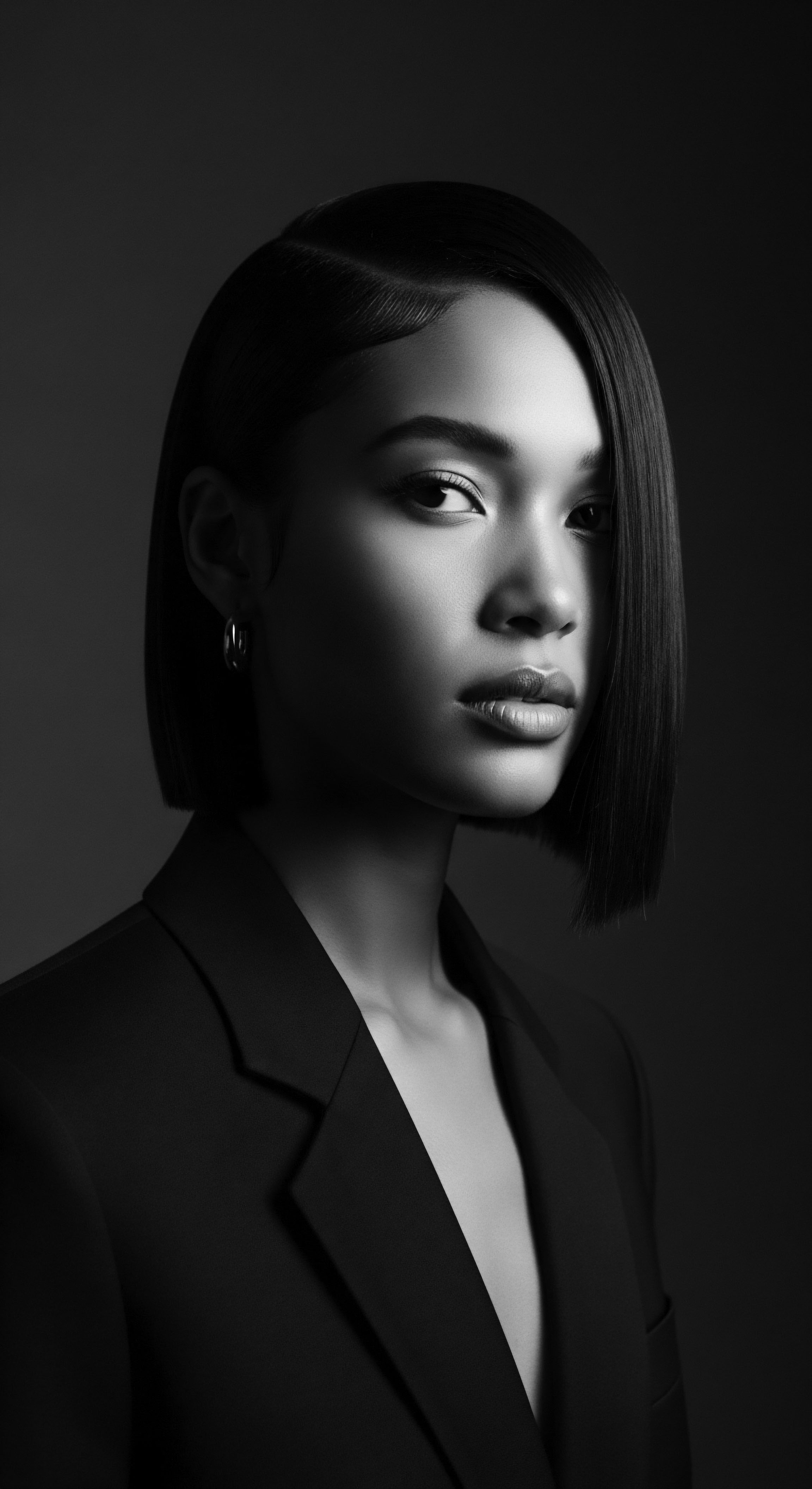
Ritual
The journey through ancient Egyptian hair care traditions reveals a tapestry of daily practices and ceremonial applications, each designed not just for aesthetic appeal but for health, comfort, and profound symbolic meaning. These ancestral practices, refined over millennia, inform our understanding of hair as a sacred extension of self, a philosophy that resonates deeply within Black and mixed-race hair heritage. The consistent use of natural ingredients and the emphasis on protective styling speaks to a wisdom that many modern routines now seek to reclaim.
Archaeological findings paint a vivid picture of this historical relationship with hair. Discoveries in the Dakhleh Oasis cemetery, for example, have unveiled mummies with their hair still meticulously styled, often coated with a fat-based substance. This substance, identified through gas chromatography-mass spectrometry as containing long-chain fatty acids like palmitic and stearic acids, was likely a styling product used during life to hold intricate coiffures in place. (McCreesh, Gize, & David, 2011) This particular finding offers a compelling historical example, demonstrating that ancient Egyptians—regardless of social status, as the product was found on both naturally and artificially preserved mummies—invested in hair maintenance and styling with products that would have benefited textured hair types by providing moisture and hold.
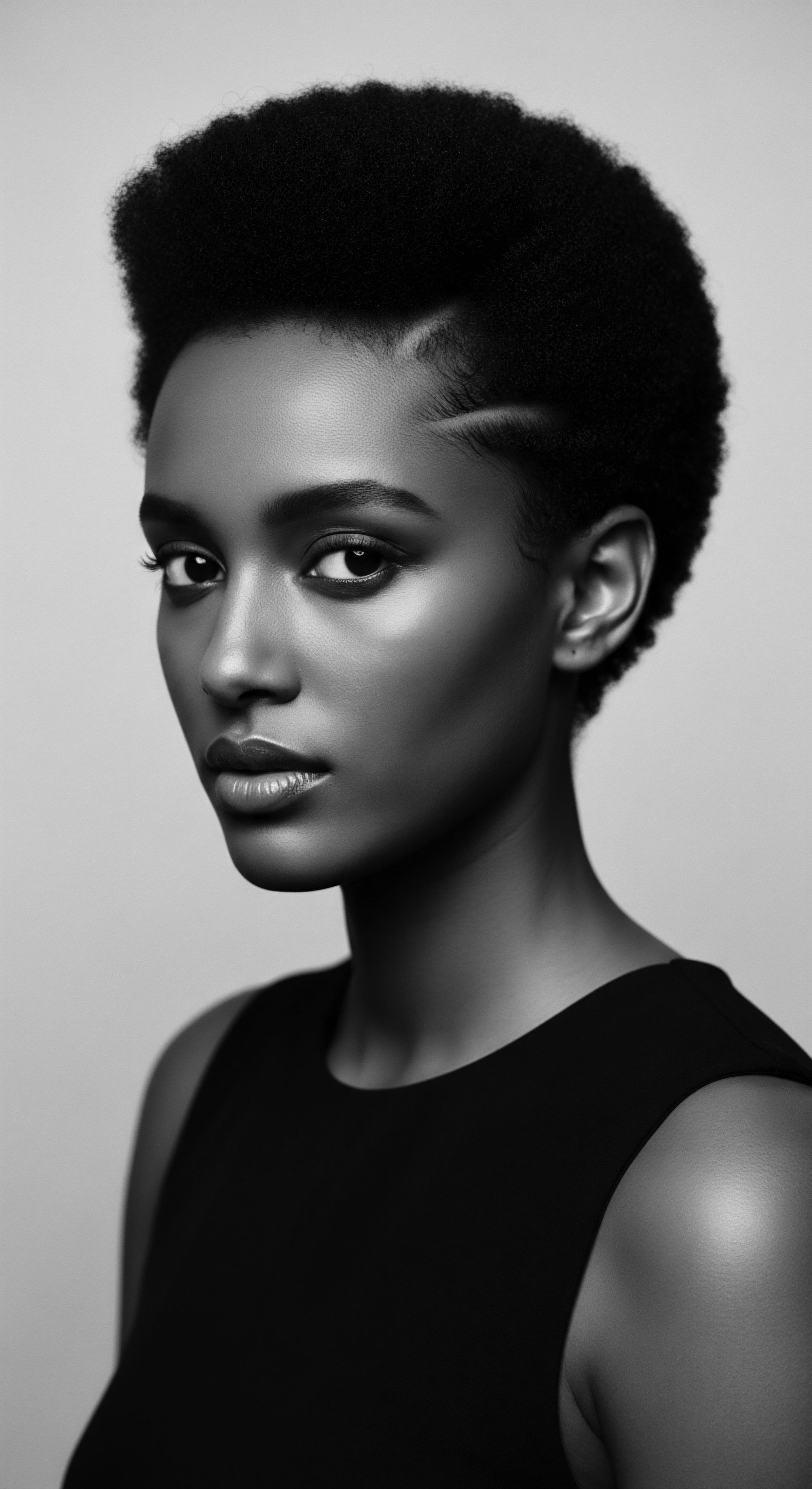
Protective Styling From Ancient Kemet
Ancient Egyptians were masters of protective styling, a practice central to the care of textured hair across the African diaspora today. Braiding, plaiting, and even hair extensions were widely practiced, protecting the hair from environmental harshness and minimizing manipulation. These styles served both practical purposes, such as hygiene and managing hair in the hot climate, and aesthetic ones, allowing for elaborate displays of artistry.
The longevity of these styles, often held by naturally derived “gels” and unguents, points to a deep understanding of how to maintain hair integrity over time. This foundational knowledge, passed down through generations, underscores the enduring legacy of protective styling as a heritage practice, designed to preserve hair health and promote growth by reducing breakage and tangles.
Ancient Egyptians utilized fat-based hair products to maintain styles, revealing a dedication to hair appearance even in death.

Early Methods of Hair Preservation
The practice of protecting hair extended into the afterlife, with mummification processes often adapted to preserve the deceased’s hairstyle. This deliberate act highlights the cultural significance of hair as a part of one’s enduring individuality. The care taken to protect hair during embalming, often by coating it with a fatty substance rather than the resins used for other body parts, shows a specific recognition of hair’s unique needs. (McCreesh, Gize, & David, 2011) This suggests a nuanced understanding of materials and their interactions with different bodily components.
| Aspect Primary Styling Agent |
| Ancient Egyptian Practices Fat-based substances (palmitic, stearic acids, possibly animal fats or plant oils) |
| Modern Textured Hair Care Parallels Butters (shea, cocoa), natural oils (coconut, olive), styling creams with fatty acids |
| Aspect Purpose |
| Ancient Egyptian Practices Hold styles, add sheen, protect from dryness, ceremonial preservation |
| Modern Textured Hair Care Parallels Define curls, reduce frizz, moisturize, protect, enhance appearance |
| Aspect Tools |
| Ancient Egyptian Practices Combs, metal implements for curling, possible bone styling tools |
| Modern Textured Hair Care Parallels Wide-tooth combs, brushes, curling irons, diffusers, styling brushes |
| Aspect Styling Goal |
| Ancient Egyptian Practices Elaborate coiffures, braids, wigs, extensions; indicative of status |
| Modern Textured Hair Care Parallels Coil definition, twist-outs, braid-outs, protective styles, healthy scalp |
| Aspect The foundational wisdom of ancient Egyptian hair care, emphasizing moisture and hold, mirrors current approaches to styling textured hair. |

Wigs and Hair Extensions ❉ Ancient Roots of Adornment
Wigs and hair extensions were remarkably prevalent in ancient Egypt, serving as markers of social standing, hygiene solutions, and artistic expressions. Crafted from human hair, sometimes augmented with plant fibers, these elaborate pieces were often set with beeswax and resins, giving them a lustrous appearance. (Ranieri Roy, 2023) The earliest known hair extensions date back to approximately 3400 BCE, discovered in a female burial at Hierakonpolis, showcasing the long history of this practice. (Fletcher and Salamone, 2016)
For many, wigs provided a practical solution to maintain hygiene in the hot climate, by allowing the head to be shaved or kept very short underneath, thus mitigating concerns of lice infestation. This practical aspect, alongside the aesthetic desire for voluminous and complex styles, made wigs a staple for the elite. The craftsmanship involved in creating a wig with hundreds of individually prepared hair strands, often coated for preservation and luster, highlights the considerable value placed on hair adornment.
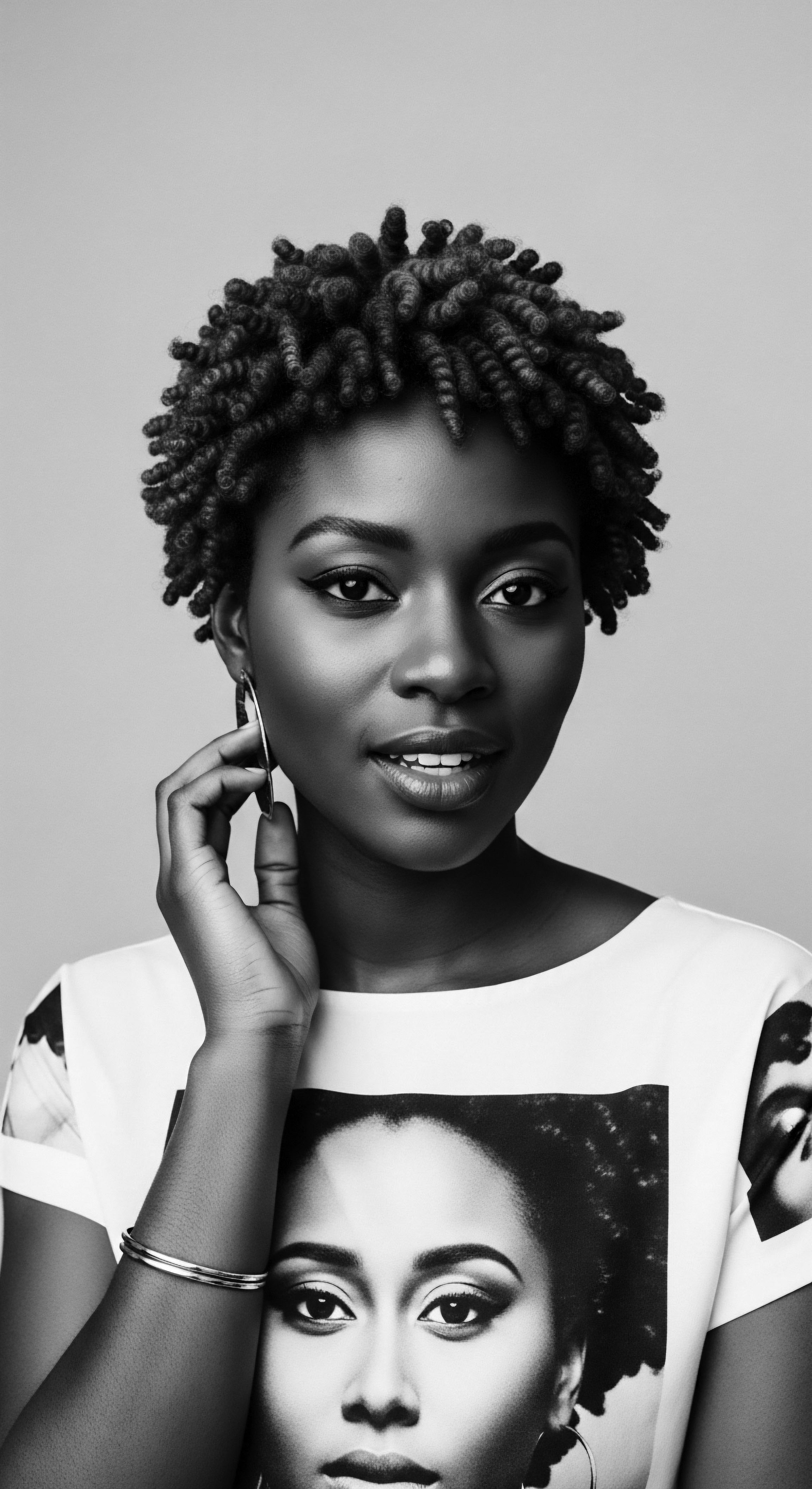
Relay
The echoes of ancient Egyptian hair care practices reverberate through the corridors of time, offering invaluable insights into the enduring relationship between ancestral wisdom and contemporary hair health. The holistic approach embraced by the Egyptians, intertwining hygiene, aesthetic, and spiritual significance, finds a compelling resonance in modern textured hair care philosophies. This lineage of thoughtful engagement with hair provides a robust framework for understanding present-day regimens, particularly those rooted in Black and mixed-race heritage.
One powerful link between ancient Egyptian ancestral practices and textured hair heritage can be observed in the consistent reliance on natural emollients. A study analyzing mummified hair from ancient Egypt, some dating back 3,500 years, identified the application of a fat-based substance containing biological long-chain fatty acids like palmitic and stearic acids. This compound was used as a styling product and was found on both naturally preserved and artificially mummified individuals, suggesting its widespread use beyond embalming. (McCreesh, Gize, & David, 2011) Such fatty acids are fundamental components of many natural butters and oils highly valued in modern textured hair care, like shea butter, which is notably rich in stearic acid and widely used across sub-Saharan Africa.
This historical data provides a compelling case study on the ancestral knowledge of how to nourish and hold hair, especially types prone to dryness, by applying lipid-rich substances. (McCreesh, Gize, & David, 2011; Marshall, 2025)
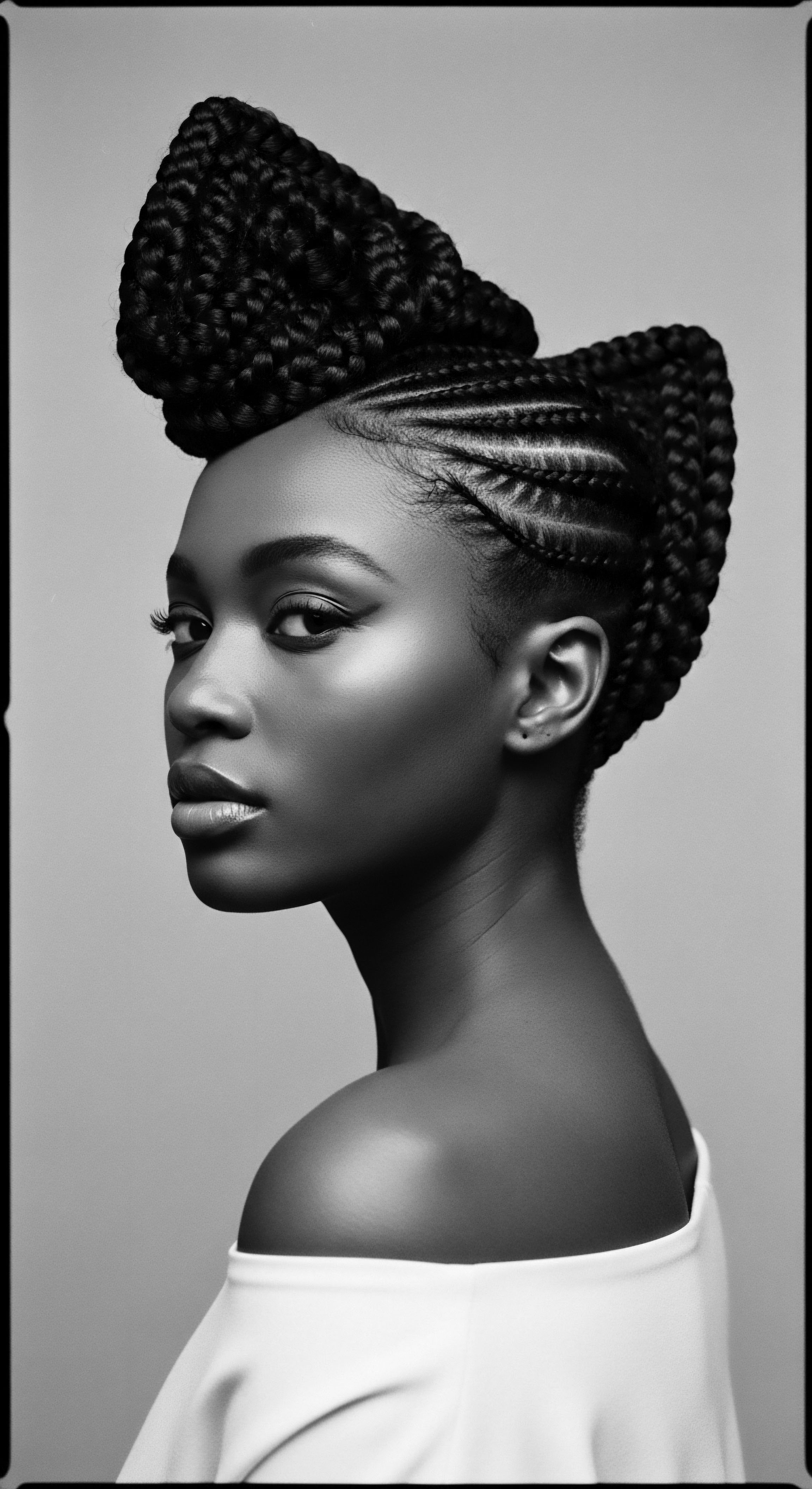
Building Regimens from Ancestral Wisdom
Ancient Egyptian hair care regimens, though uncodified in modern terms, reveal a structured approach to maintaining hair health. Regular cleansing, oiling, and protective styling formed a core component of their daily lives, often tailored to individual needs and social standing. The use of natural oils, such as olive oil and possibly castor oil, not only smoothed hair and prevented frizz but also imparted sheen, kept hair healthy, and stimulated growth. (Amazingy Magazine, 2024) This layered approach to care—cleansing, moisturizing, and protecting—forms the bedrock of effective modern textured hair regimens, reflecting a continuous thread of practical wisdom.
The consistency of these practices, adapted to the harsh desert environment, highlights their proactive stance on hair preservation. For individuals with textured hair, whose natural curl patterns can hinder the even distribution of sebum, the deliberate application of external lubricants would have been a necessity. This ancestral precedent underscores the importance of intentional product application to maintain moisture balance and elasticity, vital for preventing breakage and promoting healthy hair.
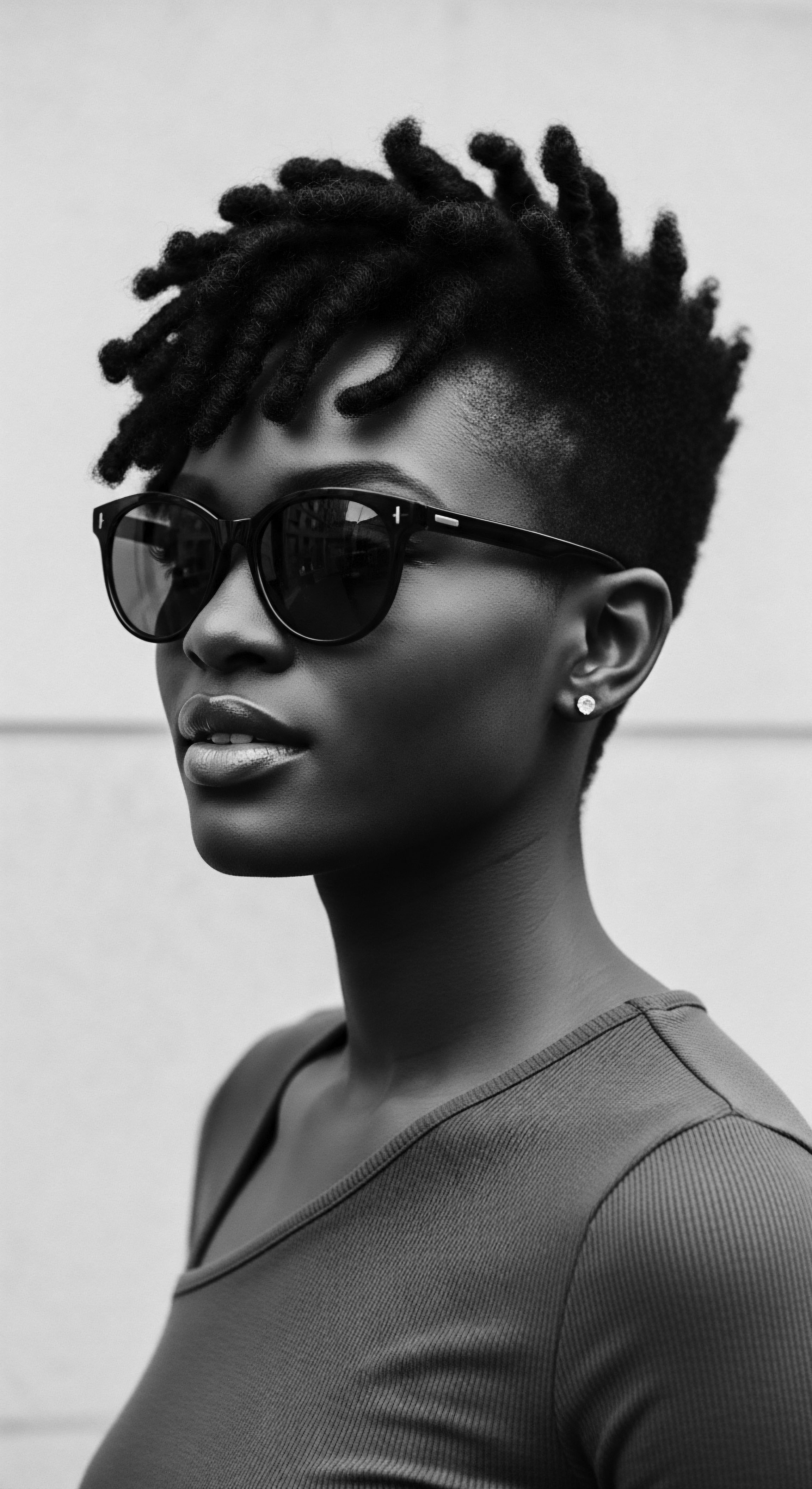
The Nighttime Sanctuary ❉ A Historical Practice?
While explicit historical texts detailing specific nighttime hair rituals are rare, the very nature of ancient Egyptian hair care, with its emphasis on elaborate, preserved styles, implies a need for nighttime protection. Wigs, for instance, were carefully stored, suggesting a conscious effort to maintain their integrity. Similarly, the meticulous application of styling products would have necessitated measures to prevent disruption during sleep.
The concept of protecting hair overnight, using wraps or coverings, is deeply ingrained in many Black and mixed-race hair traditions. It is reasonable to infer that ancient Egyptians, with their profound appreciation for hair’s longevity and appearance, likely engaged in similar protective measures to preserve their intricate coiffures.

Ingredient Deep Dives ❉ Echoes of Ancient Formulations
The ancient Egyptian apothecary provided a rich array of natural ingredients for hair care, many of which continue to be revered in traditional wellness practices. These ingredients were selected for their perceived nourishing, protective, and even medicinal properties.
- Fatty Substances ❉ Animal fats and various plant oils (like olive oil or possible castor oil) were central to their styling and conditioning agents. These provided lubrication and hold, essential for managing diverse hair types. (McCreesh, Gize, & David, 2011; Amazingy Magazine, 2024)
- Beeswax ❉ Often mixed with resins, beeswax was used to set wigs and potentially natural hair, offering a durable hold and added luster. Its occlusive properties would also aid in moisture retention. (Ranieri Roy, 2023)
- Henna ❉ This plant-derived dye was not only used for coloring hair, nails, and palms but also believed to possess hair loss treatment properties and make hair softer and thicker. (Amazingy Magazine, 2024)
These ingredients speak to an ancestral botanical intelligence, a deep understanding of the natural world’s offerings for human wellbeing. The principles guiding their use—nourishment, protection, and aesthetic enhancement—remain timeless and form a foundational aspect of holistic textured hair care today.
Ancient Egyptians formulated hair care products using natural fats, waxes, and plant extracts, reflecting a sophisticated understanding of hair’s needs.

Holistic Influences on Hair Health ❉ A Unified Philosophy
The ancient Egyptian approach to hair care was intrinsically linked to a broader philosophy of holistic wellbeing. Personal appearance, hygiene, and spiritual purity were often intertwined. Priests, for example, shaved their heads for ritual purity, though high-ranking ones might wear wigs to denote status. (Amazingy Magazine, 2024) This intertwining of body, spirit, and social presentation highlights a comprehensive view of health that extended beyond mere aesthetics.
Hair, in this context, was not an isolated feature but an integral part of one’s overall vitality and connection to the divine. The care given to hair reflected a commitment to self-preservation and preparation for both earthly life and the journey into the afterlife. This ancestral viewpoint provides a powerful counter-narrative to modern fragmented approaches, urging us to consider hair health as an aspect of our complete, interwoven being, a testament to the enduring wisdom of heritage.

Reflection
As we step back from the meticulous details of ancient Egyptian hair practices, a profound truth emerges ❉ the very heart of hair care, particularly for textured hair, is a conversation with the past. The purposeful methods, the natural elements, and the deeply symbolic uses of hair in Kemet offer more than just historical footnotes; they serve as a living archive of wisdom. The dedication to preserving styles, the intuitive understanding of moisture and hold, and the reverence for hair as an extension of identity—these are not mere coincidences when viewed through the lens of Black and mixed-race textured hair heritage.
The ‘Soul of a Strand’ ethos finds its ancient roots in these practices. Each strand, whether coiled tight or gently waving, carries the memory of ancestral hands that cleansed, oiled, and adorned. It whispers of rituals performed, of status conveyed, and of a persistent desire for health and beauty that transcended the boundaries of life and death.
This enduring legacy reminds us that our contemporary textured hair journeys are not solitary paths; they are deeply interconnected with a rich, global heritage of ingenuity and self-care. The choices we make today—from the oils we select to the protective styles we embrace—are, in essence, a continuation of dialogues initiated millennia ago, preserving and honoring the profound wisdom that continues to shape our understanding of hair as a cherished part of self.

References
- Amazingy Magazine. (2024). A History of Haircare.
- Fletcher, J. & Salamone, F. (2016). An Ancient Egyptian Wig ❉ Construction and Reconstruction. Internet Archaeology, 42.
- Marshall, A. (2025). The magic and power of hair in ancient Egypt. Ancient Egypt, 147.
- McCreesh, N. C. Gize, A. P. & David, A. R. (2011). Ancient Egyptian hair gel ❉ New insight into ancient Egyptian mummification procedures through chemical analysis. Journal of Archaeological Science.
- Ranieri Roy, L. (2023). Hair of the Pharaohs. Ancient Egypt Alive.
- Robins, G. (2020). Hair, Gender, and Social Status in Ancient Egypt. JSTOR Daily.
- Salama, M. E. & Kandil, H. A. A. (2018). Role of The Hair in Ancient Egypt. International Journal of Tourism and Hospitality Management, 1.
